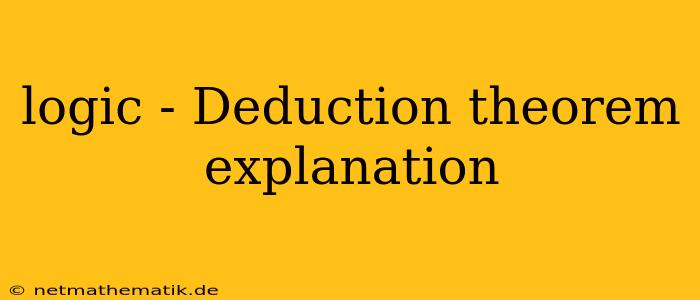The Deduction Theorem is a fundamental concept in logic, particularly in proof theory. It provides a powerful tool for simplifying proofs by allowing us to move from proving implications within a formal system to proving the consequent under the assumption of the antecedent. This theorem is crucial in understanding the structure of logical proofs and has significant implications for various areas of logic and mathematics. This article will delve into the Deduction Theorem, providing a comprehensive explanation of its statement, proof, and applications.
Understanding the Deduction Theorem
The Deduction Theorem, often referred to as the Deduction Rule, states that if a formal system can derive a conclusion B from a set of premises, including a specific premise A, then the system can derive the implication A → B from the remaining premises without A. In simpler terms, if we can prove B assuming A, then we can also prove that A implies B.
Formally, the Deduction Theorem can be expressed as follows:
If Γ ∪ {A} ⊢ B, then Γ ⊢ A → B
Where:
- Γ represents a set of premises (also known as a context or theory).
- A is a specific premise.
- B is the conclusion.
- ⊢ signifies a derivation or proof within the formal system.
Proof of the Deduction Theorem
The proof of the Deduction Theorem generally involves induction on the length of the derivation of B from Γ ∪ {A}. This process involves demonstrating that the theorem holds for a base case (the simplest derivation) and then showing that if it holds for derivations of a certain length, it also holds for derivations one step longer.
A typical proof structure might include the following steps:
- Base Case: If the derivation of B from Γ ∪ {A} is just B itself (i.e., B is a premise), then A → B can be derived directly from B using the rule of Implication Introduction.
- Inductive Step: If B is derived from Γ ∪ {A} using a rule of inference, then we need to consider each possible rule. In each case, we show that if the Deduction Theorem holds for the premises of the rule, it also holds for the conclusion B.
Applications of the Deduction Theorem
The Deduction Theorem has numerous applications in various areas of logic and mathematics, including:
- Simplifying Proofs: By allowing us to move from proving implications to proving consequents under assumptions, the Deduction Theorem significantly simplifies proof construction. We can focus on deriving the conclusion B under the assumption A rather than directly proving the implication A → B.
- Formal System Design: The Deduction Theorem plays a crucial role in defining and analyzing formal systems. It helps ensure the consistency and completeness of axiomatic systems by providing a powerful tool for deriving new theorems from existing ones.
- Automated Reasoning: The Deduction Theorem is fundamental to automated theorem proving techniques. It allows for the development of algorithms that can efficiently search for proofs within complex formal systems.
- Meta-Logic: The Deduction Theorem is used to analyze the properties of logical systems themselves. It helps us understand the relationships between different logical principles and the power of various proof systems.
Examples of Deduction Theorem Use
To illustrate the practical application of the Deduction Theorem, consider a simple example in propositional logic:
Premise: P → Q Premise: P Conclusion: Q
Using the Deduction Theorem, we can deduce that P → Q is equivalent to P ⊢ Q. This means that if we assume P, we can prove Q. The proof is straightforward, as we can directly derive Q from P and the premise P → Q using the rule of Modus Ponens.
Conclusion
The Deduction Theorem is a cornerstone of logic, providing a powerful tool for simplifying proofs and understanding the structure of formal systems. Its applications span various areas of logic, including proof theory, automated reasoning, and meta-logic. By allowing us to move from proving implications to proving consequents under assumptions, the Deduction Theorem has significantly impacted the development and understanding of logic and its applications in mathematics and computer science. Further exploration of the Deduction Theorem and its applications is crucial for gaining a deeper understanding of formal systems and their role in reasoning and knowledge representation.
